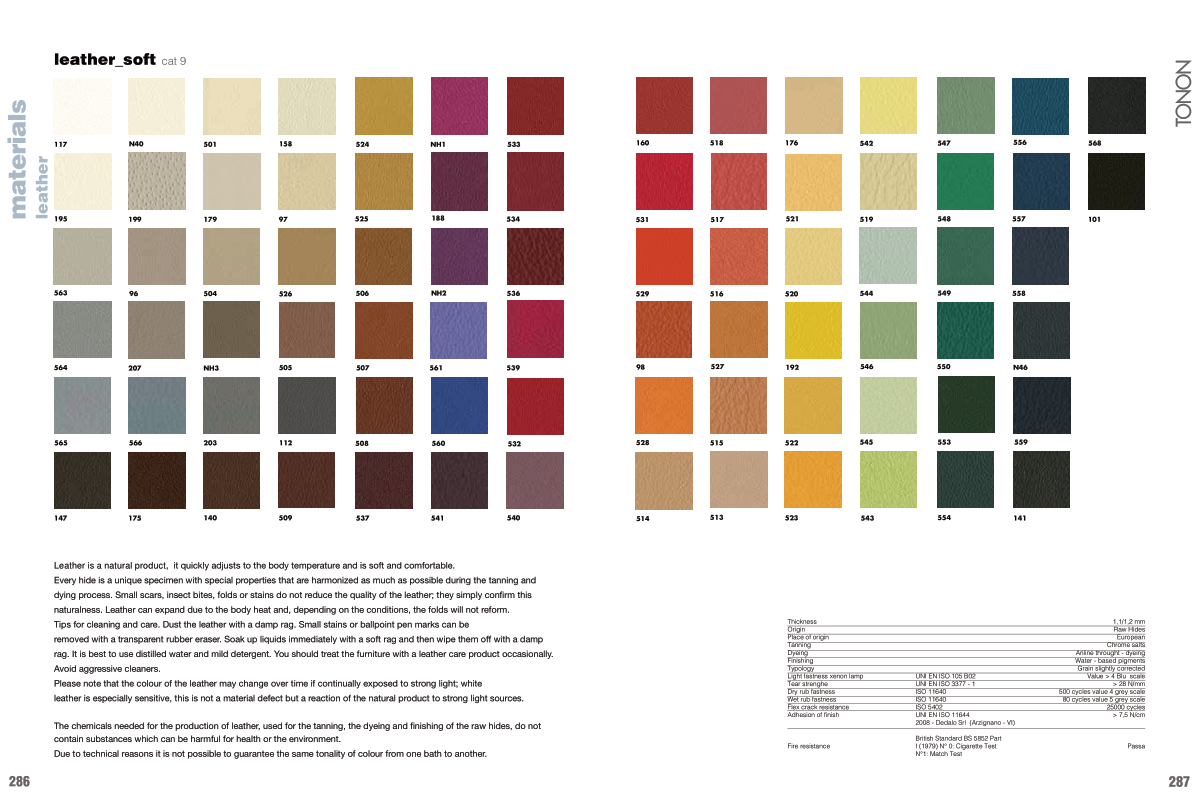leather_soft cat 9
NH3
528
537
N46
526
527
203
544
565
523
533
549
207
192
524
556
188
546
564
522
112
548
566
176
525
557
117
195
N40
199
158
179
96
97
563
504
506
558
539
554
147
101
513
531
516
520
509
559
507
560
532
514
NH1
543
534
550
540
547
518
529
140
141
508
561
541
542
517
521
98
NH2
545
175
568
160
519
536
553
Thickness
Origin
Place of origin
Tanning
Dyeing
Finishing
Typology
Light fastness xenon lamp
Tear strenghe
Dry rub fastness
Wet rub fastness
Flex crack resistance
Adhesion of finish
Fire resistance
1,1/1,2 mm
Raw Hides
European
Chrome salts
Anline throught - dyeing
Water - based pigments
Grain slightly corrected
Value > 4 Blu scale
> 28 N/mm
500 cycles value 4 grey scale
80 cycles value 5 grey scale
25000 cycles
> 7,5 N/cm
Passa
UNI EN ISO 105 B02
UNI EN ISO 3377 - 1
ISO 11640
ISO 11640
ISO 5402
UNI EN ISO 11644
2008 - Dedalo Srl (Arzignano - VI)
British Standard BS 5852 Part
I (1979) N° 0: Cigarette Test
N°1: Match Test
501
505
515
287
286
materials
leather
Leather is a natural product, it quickly adjusts to the body temperature and is soft and comfortable.
Every hide is a unique specimen with special properties that are harmonized as much as possible during the tanning and
dying process. Small scars, insect bites, folds or stains do not reduce the quality of the leather; they simply confirm this
naturalness. Leather can expand due to the body heat and, depending on the conditions, the folds will not reform.
Tips for cleaning and care. Dust the leather with a damp rag. Small stains or ballpoint pen marks can be
removed with a transparent rubber eraser. Soak up liquids immediately with a soft rag and then wipe them off with a damp
rag. It is best to use distilled water and mild detergent. You should treat the furniture with a leather care product occasionally.
Avoid aggressive cleaners.
Please note that the colour of the leather may change over time if continually exposed to strong light; white
leather is especially sensitive, this is not a material defect but a reaction of the natural product to strong light sources.
The chemicals needed for the production of leather, used for the tanning, the dyeing and finishing of the raw hides, do not
contain substances which can be harmful for health or the environment.
Due to technical reasons it is not possible to guarantee the same tonality of colour from one bath to another.


